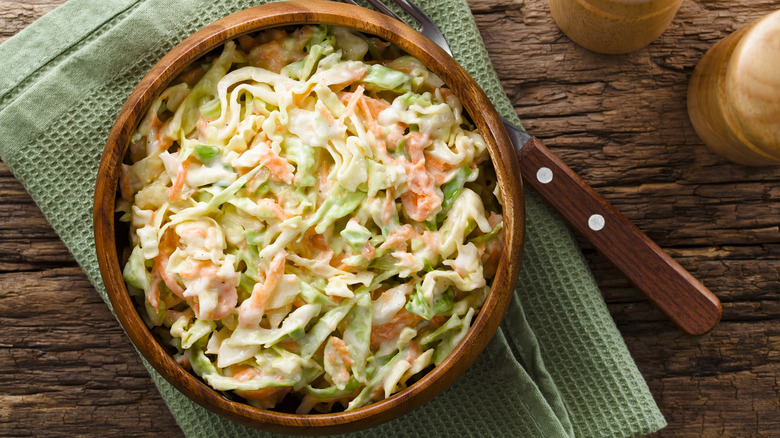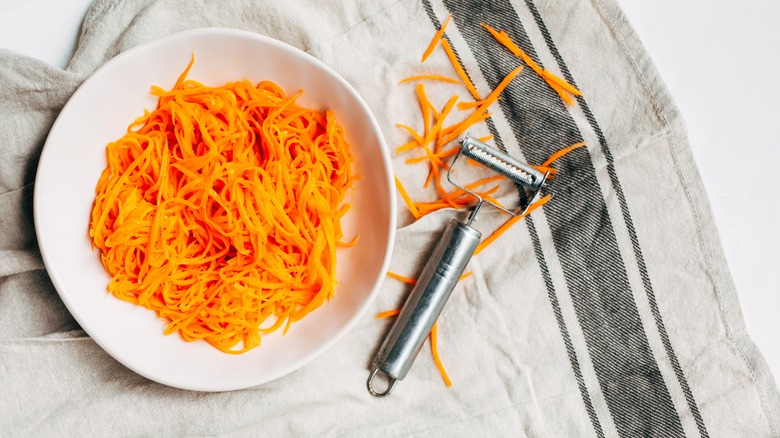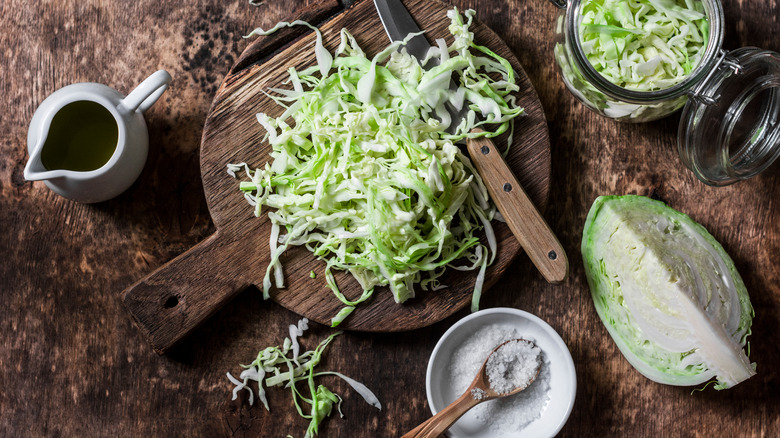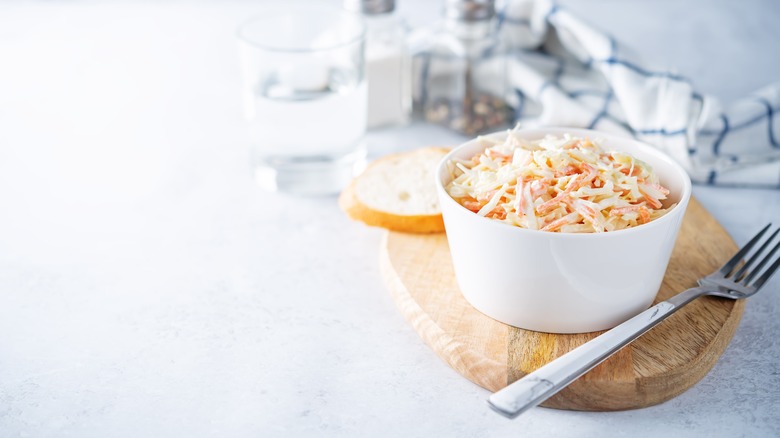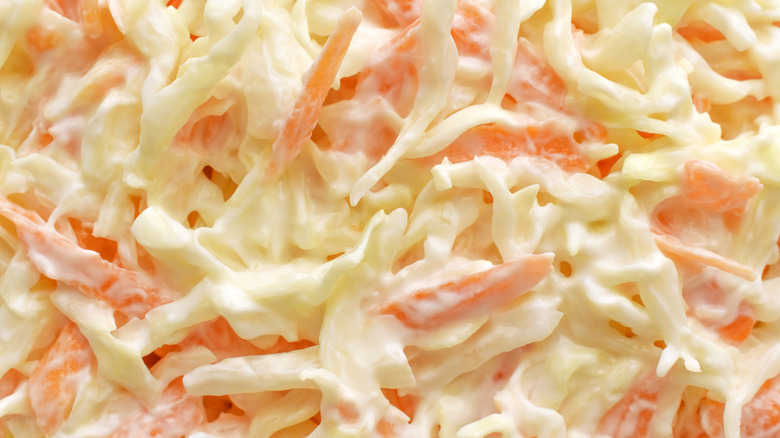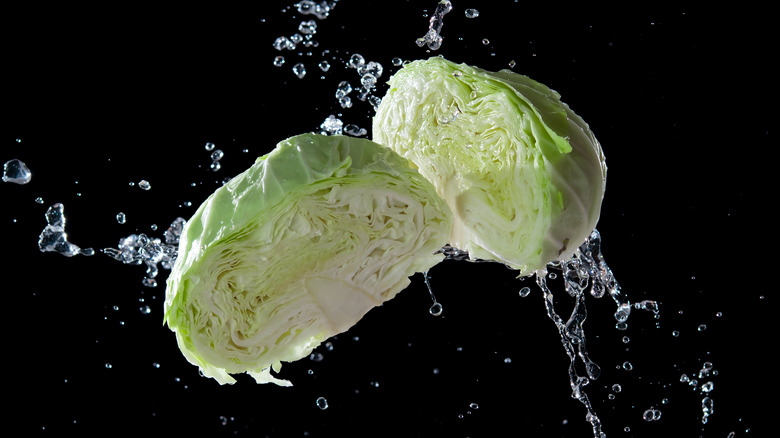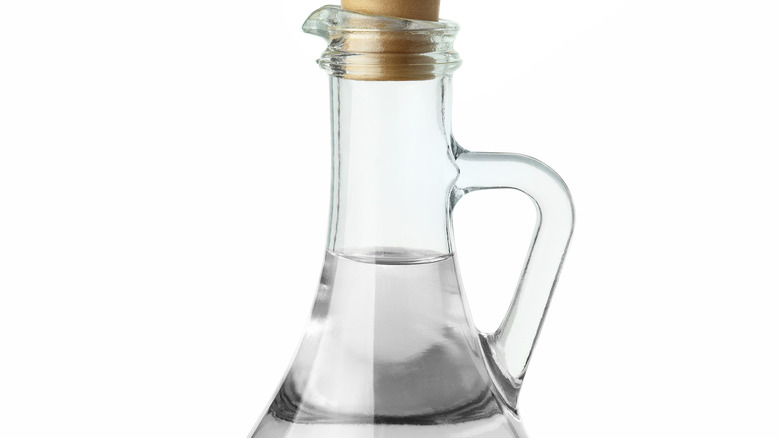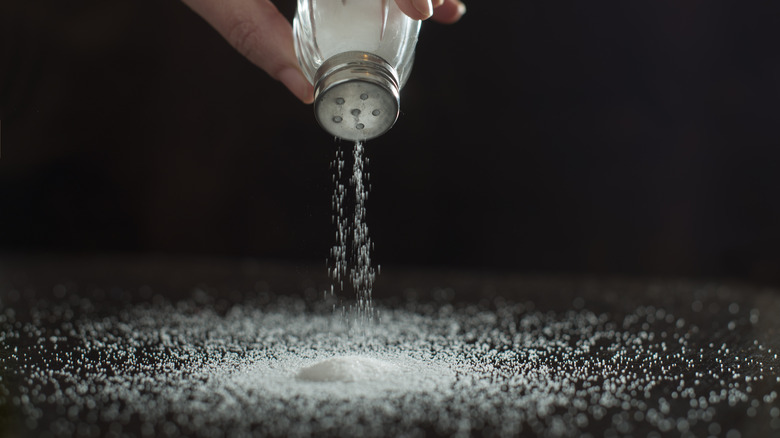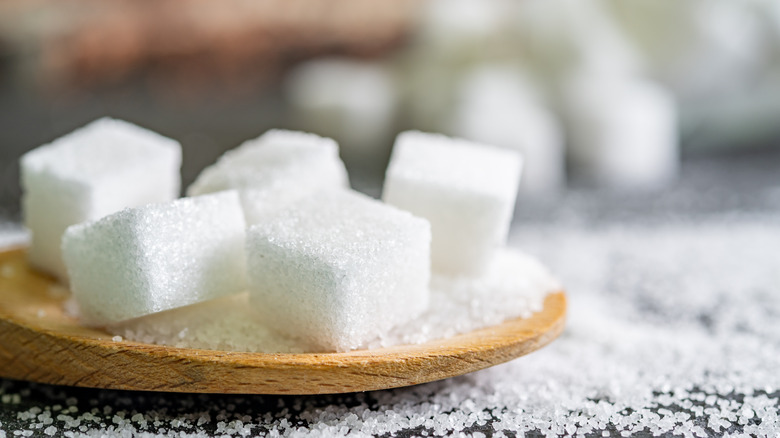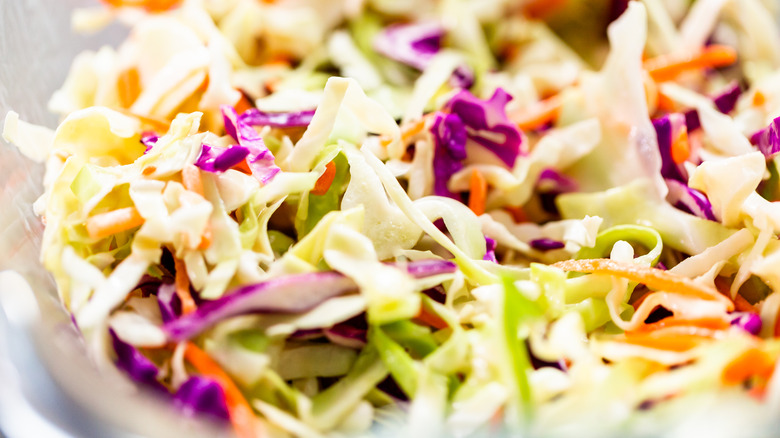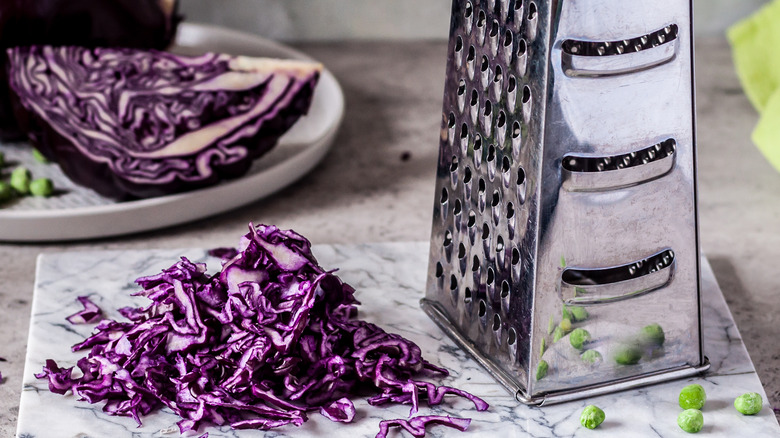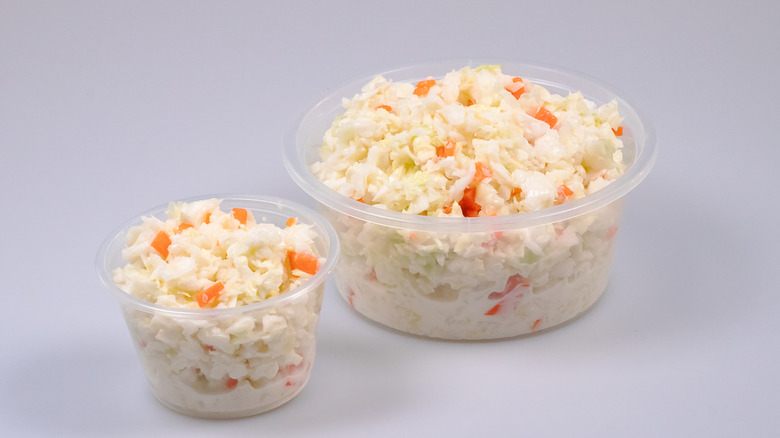Mistakes Everyone Makes When Making Coleslaw
An American staple for ages, there's nothing like a creamy bowl of coleslaw. This ultimate companion for your fried chicken and barbecued meat is the source of some heated debates: Should you use vinegar or mayonnaise? How much sugar should you add to the dressing? Even so, there's nothing stopping most people from devouring this creamy goodness. Making coleslaw at home means you can make a healthier version if you prefer, one low on mayonnaise and sugar. You can also make it with mustard, add several vegetables (think onions and cucumbers), or stuff it with apples. The beauty of coleslaw is that it's infinitely adaptable, but that doesn't mean that anything goes when preparing this cold summer treat. You can definitely screw up coleslaw, and many people make laws that are destined to be picked at and then discarded in favor of tastier items at the backyard barbecue.
If you're not too well-versed with making homemade slaw, you've come to the right place. We've collected some of the most common mistakes that people make when they prepare coleslaw at home. Knowing the potential mistakes means you can work to avoid them and ensure a delicious slaw every time. Whether coleslaw is something you eat regularly or indulge in occasionally, keep reading ahead to make sure you never mess it up again.
Not shredding your carrots
Who doesn't like to munch on fresh, crunchy carrots? Adding them to your tasty coleslaw amps up the texture and flavor profile of the salad. But you can't just chop them up and toss them in a salad. Nope, carrots require being carefully shredded and then gently tossed with the other ingredients.
It is recommended to add shredded carrots for the perfect consistency of a restaurant-quality coleslaw — a dish that deserves to be the sidekick to almost any food. Cutting your carrots into circles or chunks is a big mistake. Big chunks of carrots are too hard and crunchy to blend with the rest of the dish. Shredding them in a proper size is a valuable technique for making a delicious coleslaw. You can use either a food processor or a regular kitchen grater to do the job, per Livestrong. That will make the carrot pieces harmonize with the shredded cabbage and other vegetables. A good rule of thumb is that you want all the different components of your coleslaw to be basically the same shape and size.
Not salting your cabbage first
Dry your tears; we're here to save your coleslaw from becoming too watery and sad to be eaten. Imagine digging into your coleslaw only to find it soggy and limp. Off-putting, isn't it?
Coleslaw should be adequately seasoned with dressing and served fresh. One of the ways you can make sure it has the perfect texture is to add salt to the cabbage. Cabbage is mainly made of water; once it is cut, the water starts leaking out. That water will dilute your dressing and make your vegetables swim in an unappetizing pool of bland liquid. Salting your cabbage allows water to be drained from the coleslaw to save your tasty side dish from becoming a disastrous soup.
According to Recipe Land, you can salt your cabbage in a few simple steps. First, put your shredded cabbages with a teaspoon of salt in a colander and toss. Let it sit for one to four hours, and then drain out as much liquid as you can. Pat it dry with a paper towel. Now your cabbage is ready to be tossed with other ingredients like mayo and carrots to make delicious coleslaw.
Per a user on Reddit, you need to salt both carrots and cabbage after they are shredded to leach out the water and make them soft and tender.
Adding dressing too early
After you've prepared your vegetables, the logical thing to do next is to dress your salad. But it is imperative to note that coleslaw should never be dressed too early or too late, especially when you want one that is both tasty and crunchy.
According to De Kooktips, you should always add dressing to the coleslaw gradually and slowly. You can start by putting in little amounts of dressing and gently toss or mix it up each time. It's safe to mix in your dressing 20 minutes before serving. Any later, and we're afraid you won't have a perfect crunch factor of the vegetables. Any sooner, and your dressing won't be appropriately marinated.
If you're making your coleslaw early or preparing it for the next day, store both your vegetables and the dressing separately in an airtight container in the fridge. Do not add the dressing; otherwise, the next day, you'll be opening your fridge to a watery coleslaw that tastes as disappointing as it looks.
Although coleslaw is okay to eat for a few days after it's prepared, it's best not to serve a coleslaw you've made the day before if you can avoid it. According to a user on Reddit, the coleslaw starts to lose its color, the cabbage loses its crunch, and it's just not presentable to be served or consumed.
Not storing it properly
As you take a bite of your delicious coleslaw, you mentally give yourself a pat on the back for a job well done. Now make sure you reap the benefits to the fullest and not make the mistake of improperly storing it. Not only will it save you from heartache, but it will save your favorite snack from becoming a disaster.
Whether you've whipped it up yourself or got yourself a store-bought coleslaw, it's common sense that this salad is never meant to be kept too long.
Coleslaw salad goes bad after a few days. It will not last for more than three to four days, kept in an airtight container. The four days maximum lifespan is a rule of thumb, but it does depend a lot on your ingredients. If you're using mayonnaise, then, of course, it's bound to spoil sooner than the vinaigrette version.
According to Does It Go Bad, you can tell your coleslaw has gone bad if you see any signs of mold, discoloration, foul odor, or if it has been stored for too long. Go with your gut instinct with this one, and your stomach will thank you.
The vegetables will lose their luster and become too watery if stored for too long. Not to forget, it will not taste very good. Before serving, always check for signs of spoilage and make sure the spoon you are using to scoop and prepare it is adequately washed (via Fitbility).
Not washing your cabbage first
On a time crunch and looking for the quickest way out with a bowl of fresh coleslaw in hand? Well, not washing your vegetables is certainly not the way to go.
Sorry to disappoint, but all fresh produce needs to be washed thoroughly. Cabbages especially need a thorough treatment under running water, and pulling off the first few layers isn't going to do much for you.Cabbage is a naked fruit. While you can remove the first two outer layers of cabbages, they don't have any hard outer covering or shell that will naturally protect them from dirt and bacteria, so worms and insects can find their way inside.
According to the Times of India, the best method of washing cabbages is by first removing the two outer coverings, then cutting or shredding them. Next, dip them in water mixed with vinegar and let them sit for a couple of minutes. You can then rinse them under running water, and your cabbages are safe to be consumed.
A Reddit user narrates how restaurants wash their produce. When it comes to leafy greens, like cabbages, restaurant workers soak them in a sink full of cold water, and sediments and residue will drift towards the bottom, and then they'll use a spinner to dry it quickly.
Adding too much vinegar
Any classic coleslaw recipe will include a splash of vinegar; whether you use cider, rice, or white vinegar is up to you (and your recipe). But you must remember that white vinegar has a stronger taste than the other three and has a far more acidic bitter flavor. Sometimes we tend to go overboard with it to get more flavor and tang, which results in a strong, pungent taste.
Since we don't have a time machine to take us back to the past, we might just as well follow some hacks to rectify the situation. According to the Oven Via, you can add sugar or salt to your coleslaw to counter the sourness of vinegar.
Another remedy is adding more ingredients so the vinegar and the vinegary taste are evenly distributed. Add more yogurt and mayonnaise or shred a few more vegetables and toss them in the coleslaw (via Boss The Kitchen).
According to a user on Quora, if your coleslaw tastes bitter due to vinegar, you can add shredded apples instead of sugar in order to counterbalance the flavors. If nothing works, we have found the perfect little tip for you to try out. You can add more cream to the coleslaw, which will not only knock out the taste of vinegar but will make your coleslaw more creamy and delicious.
Going overboard with the salt
Putting too much salt is a mistake everyone makes once in a while. Whether you attribute the reason to forgetfulness or an error of estimation, the result is the same — salty, bitter food that makes you go "yuck."
Go on, rinse your mouth, but don't throw your food away. The classic mistake can be rectified quite easily. According to SFGate, you can add more vegetables to your coleslaw to dilute the strong salty flavor. Shred more cabbage and add more dressing to it until you reach the desired flavor. Or you can make another batch but do not put salt in it and combine the two coleslaws. In the wise words of a Reddit user, "The solution to pollution is dilution."
Moreover, to counteract the saltiness, you can also add cream or sugar to tone it down. If neither of the two is a good option for you, then you can try splashing your salty coleslaw with a drizzle of vinegar. The tartness and acidity will counteract the salty taste of the food, giving you a fresher flavor.
If you haven't added the dressing yet, you can rinse the vegetables under running water or soak them to remove excess salt.
Adding too much sweetener
Adding too much of anything, regardless of how much you like it, is likely to result in a culinary disappointment.
Most of the time, recipes call for adding sweetener to balance the acidity and the tang of both the vinegar and lemon in coleslaw dressing. You can add sweetener in the form of sugar, but honey and maple syrup are also great options. You should avoid adding too much sugar, which gives you a rather too sweet coleslaw. Sweet coleslaw can overpower the flavor of other ingredients, so make sure to use proper quantities of sweetener every time.
But, if you've already added too much, don't worry. There are a few tricks up our sleeves to save the day. The first one is to add vinegar to your dish. Per a user on Reddit, the bite of the vinegar takes out the sugary aspect of your coleslaw. You can use white vinegar or apple cider vinegar.
You can also add other ingredients to balance out your dressing's flavor. According to Top Cooking Stories, you can add a squeeze of lemon juice or non-dairy yogurt so that the tang can help moderate the sweetness. You can also drizzle in some olive oil or avocado oil so the sweetness is reduced.
Making it too early
While there are many dishes and recipes that you can make in advance, salads like coleslaw are a big fat no. It's culinary common sense that leafy greens will lose their crunch and freshness if they sit in dressing for too long, but there are even more reasons to avoid making coleslaw ahead of time.
When you shred your cabbage, the plant's cell walls are destroyed, resulting in its natural oils becoming separated from sugar molecules that are part of cabbage leaves. Subsequently, they start to release a bitter compound.
At first, this bitterness goes unnoticed and is perceived as a fresh tanginess, subdued by the flavors of the dressing. But as time passes, the bitterness overpowers the salad resulting in a harsh, pungent taste. So you can see why making coleslaw in advance for later use should be avoided (via Science Of Cooking).
Moreover, the ingredients in the coleslaw will start to become soggy and release water as they begin to lose their freshness. According to Boss The Kitchen, you can make coleslaw up to eight hours before serving. Make sure to keep the ingredients separate from one another until you are ready to serve them. Plus, it's best if you use the freshest of fresh vegetables to serve them at their prime.
Not keeping it simple
It's a simple rule in the kitchen that too many ingredients can ruin your dish. Many recipes on the internet call for a splash of this, a trickle of that, and various techniques for standing out or getting reviewed as The Best Recipe, per a user on Reddit. But the truth is, the more you complicate things, the worse your food will taste.
This is because food is all about balance. The goal is to achieve perfect harmony between every element by creating just the right texture, consistency, and flavor. When adding too many ingredients to coleslaw, chances are you'll end up ruining the dish.
A typical coleslaw recipe calls for shredded cabbages and carrots, mayonnaise, vinegar, and lemon juice or sugar. The more you add to the dressing, the more difficult it will become to get all the ingredients to complement one another.
The popular show "MasterChef" is the embodiment of complicated dishes that get rated highly, per the Independent. In contrast to the fussy, overcomplicated dishes cooked on that show, many chefs and home cooks now prefer simplicity and good, honest flavor. It might be mundane to keep it plain, but simplicity is the way to go.
Not freezing your coleslaw
Wondering what to do with the leftover coleslaw? Or thinking of a way to store coleslaw as summertime approaches? Well, we have the most straightforward, and easiest trick of all: freeze it.
Yup, this easy peasy hack is all you need to save your coleslaw from spoiling, developing mold, or producing a foul odor that promises to make you retch.
Coleslaw is best enjoyed during the summer because salads are a refreshing treat to beat the heat. You can freeze it, but only the vinaigrette or lemon juice one type. Freezing mayonnaise-based coleslaw is not recommended as it tends to turn watery, and its ingredients lose their flavor when thawed.
The best part is that you can freeze it for up to 6 months if you have leftover coleslaw (via Mica Restaurant). Hurry up and freeze it because if left outside or in the heat for a long time, it'll not taste right when thawed later.
If you're planning on making a batch and freezing it, it is suggested that you freeze the shredded vegetables and add the other ingredients when you want to eat them. But if you're going to freeze the finished product, make sure that you store it in a tightly-closed container, glass jar, or zip lock bag. Make sure to leave some headspace as the coleslaw will expand after freezing. Lastly, don't forget to label the container so you know the exact expiration date.
